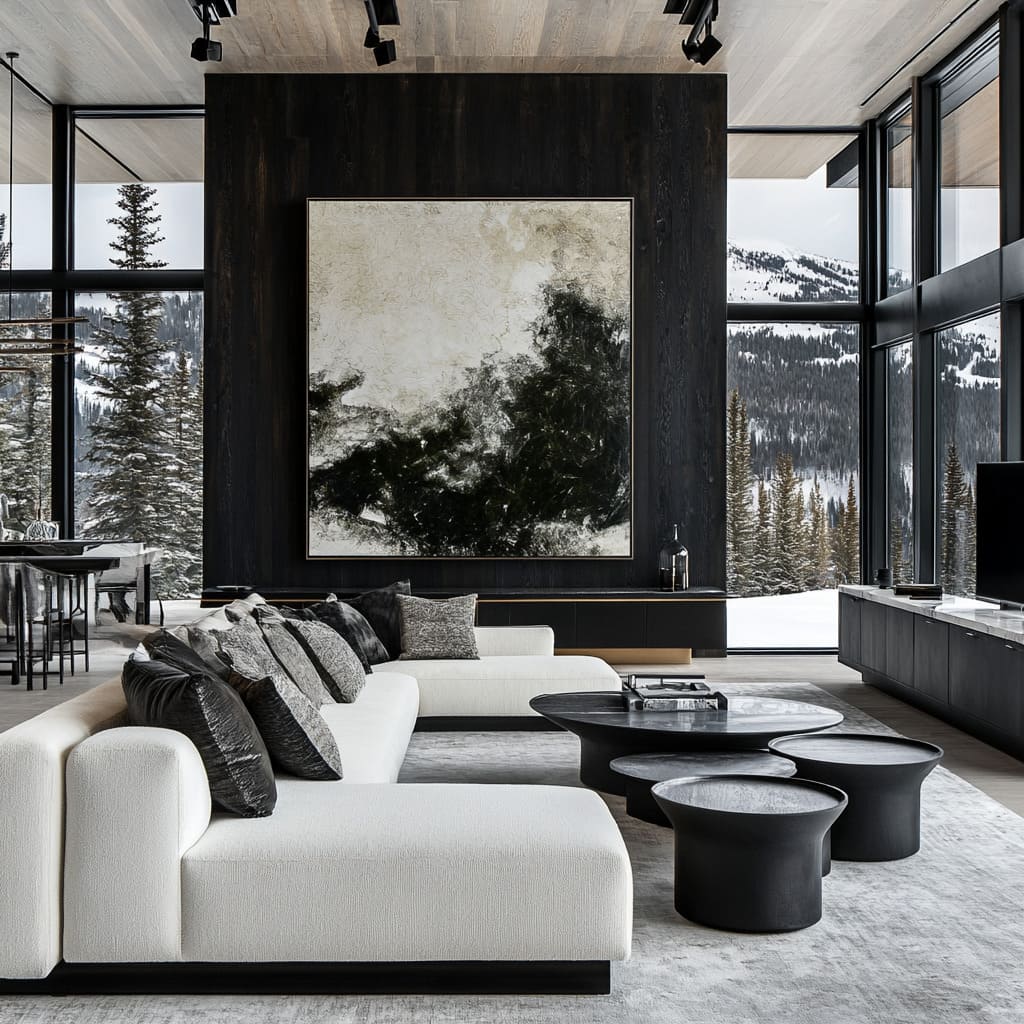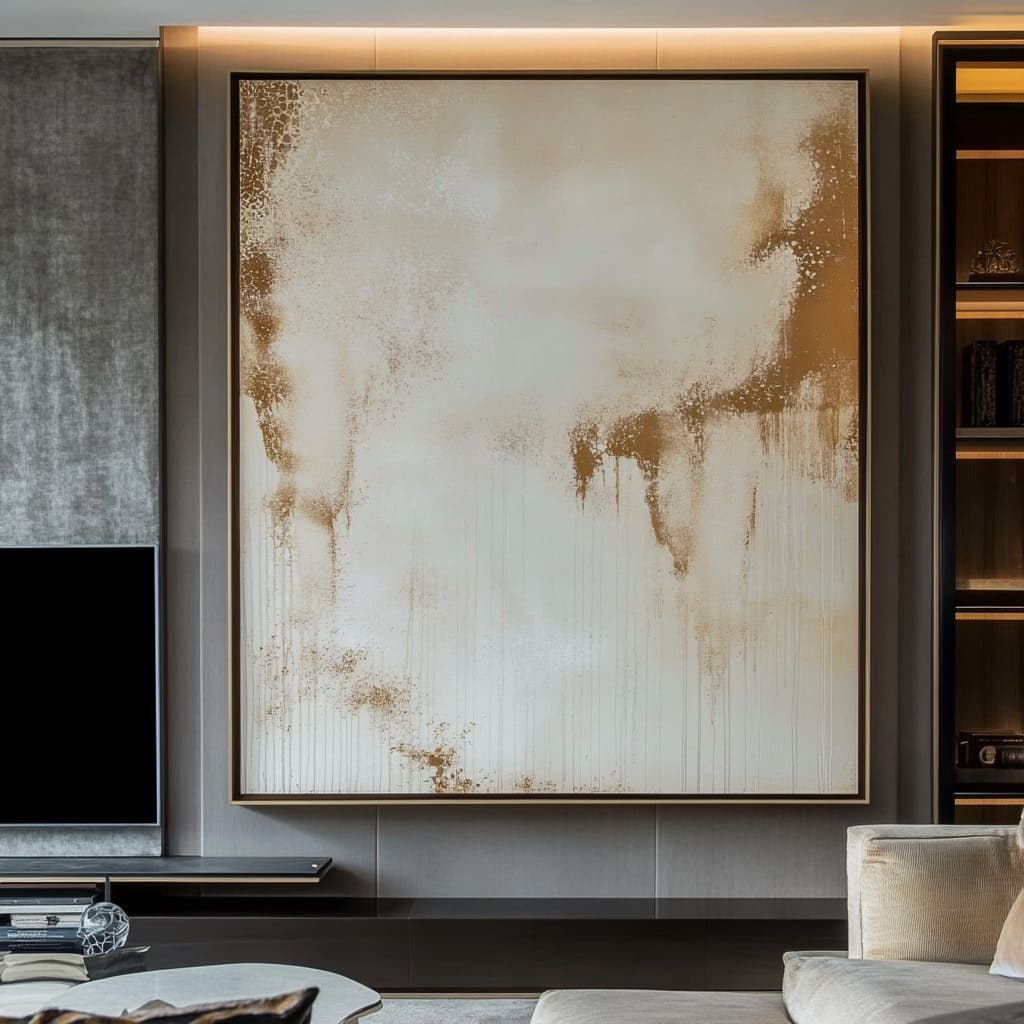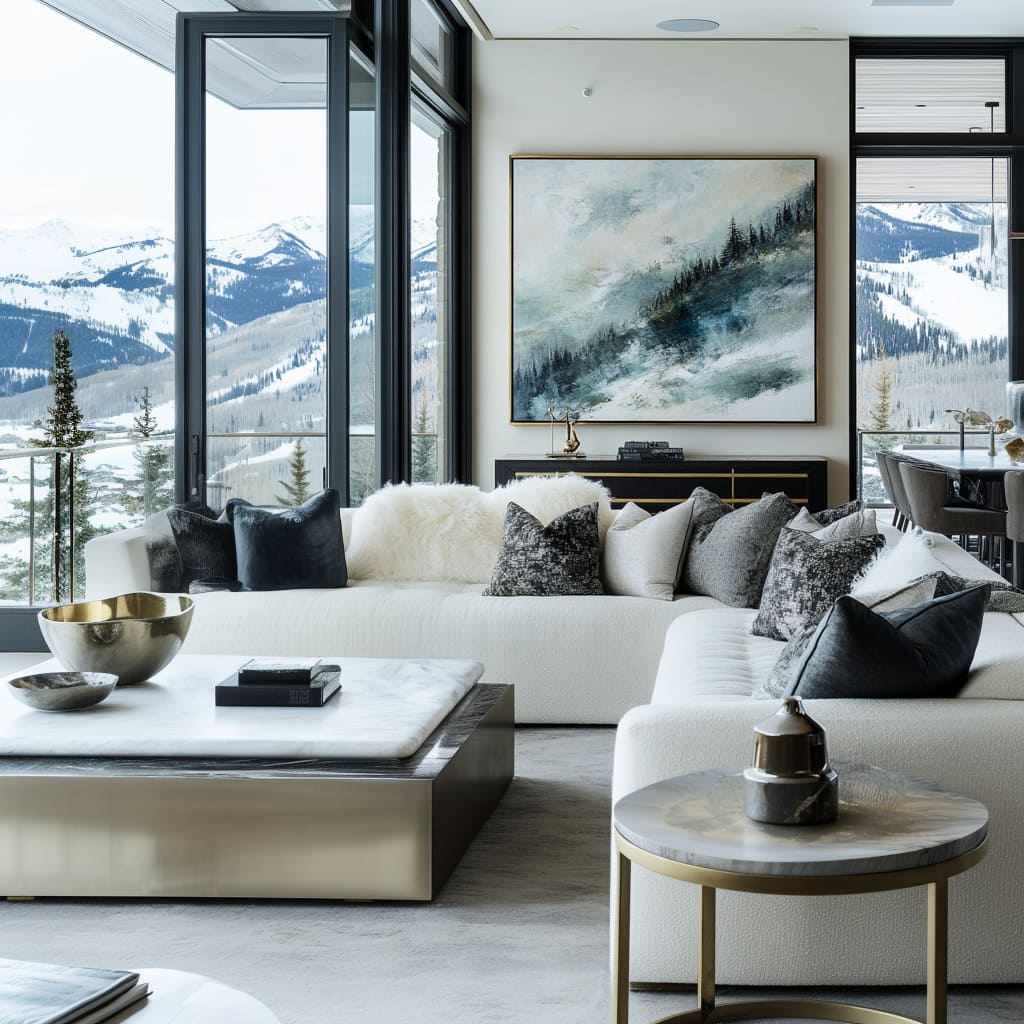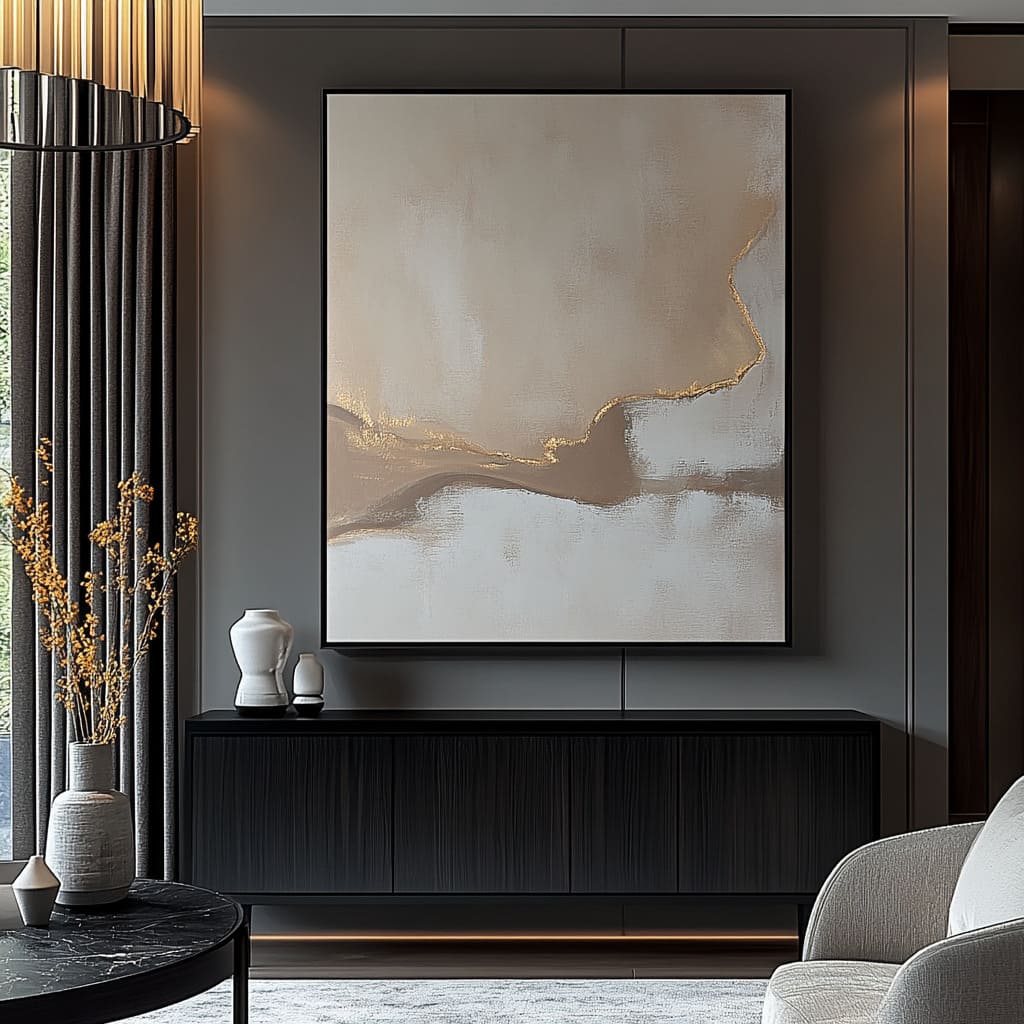Art has always been more than just decoration; it’s a way to express personality and set the tone for a space. In modern interiors, large wall paintings have become a defining feature, going far beyond their traditional role as supporting elements.
With their ability to draw attention and create a mood, these oversized pieces are reshaping the way we think about design.
One of the reasons behind the rising popularity of large wall art ideas is their unmatched versatility. Whether your home leans toward minimalism, transitional design, or something entirely unique, a striking painting can bridge the gap between functional furniture and style.
Think of it as the missing piece that brings your room to life while reflecting your personal taste. In living rooms especially, these paintings have become transformative.
Modern spaces with clean lines often incorporate large wall ideas for living room designs to break monotony and add personality. With just one thoughtfully chosen artwork, an entire room can shift from simple to stunning.
In this article, we’ll explore how oversized paintings can define spaces, bring color cohesion, and introduce a dynamic focal point to a room. Through modern, transitional, and minimalist examples, you’ll see how this design element elevates interiors while making a bold statement.
Whether you’re considering abstract textures, earthy tones, or metallic finishes, the right large painting could be the key to your next design transformation.
The Role of Large Wall Paintings in Interior Design
Anchoring the Space
A large wall painting does more than fill an empty wall; it defines the heart of the room. Its commanding presence naturally draws the eye, giving the space a focal point that brings balance and order to the overall design.
In open layouts, where boundaries between living areas often blur, a bold artwork helps establish zones and adds depth to the environment.
When paired thoughtfully with furniture, the painting acts as a visual anchor. Imagine a contemporary living room with neutral tones: a vibrant abstract painting above the sofa creates contrast, while its size ensures it isn’t overshadowed by other elements.
This interplay between art and furniture creates harmony, ensuring that even expansive spaces feel cohesive and intentional.
Oversized art also has a way of emphasizing the seating arrangement. A carefully placed painting can subtly guide where furniture should sit, framing the room around it.
In homes with open concepts, this technique allows for natural flow while making the space feel grounded. If you’re looking for ideas for large wall decor that combine both style and function, this approach delivers impactful results every time.
Enhancing Architectural Features
High ceilings, expansive walls, and open layouts can sometimes feel overwhelming to decorate, but oversized artwork turns these challenges into opportunities. A vertical painting, for instance, draws attention upward, emphasizing ceiling height and making the room feel even more spacious.
This works beautifully in homes with modern or transitional designs, where minimalism leaves room for large-scale statements.
Horizontal pieces, on the other hand, elongate walls and create a sense of balance in wide spaces. Whether placed above a sideboard or a sprawling sectional, these artworks introduce structure while echoing the proportions of the room.
The result is a look that feels both dynamic and carefully curated.
In areas where architectural features already stand out—like textured walls or oversized windows—a large painting can complement rather than compete. Abstract compositions with subtle tones can enhance natural light, while more dramatic pieces can contrast beautifully with dark wood or metallic finishes.
The key is ensuring the art works with, rather than against, the room’s architecture, creating an interior that feels thoughtfully designed and visually captivating.
Style Elevation Through Color and Texture
Adding Depth and Personality
Abstract art has an incredible ability to transform a room by introducing layers of complexity that go beyond what traditional decor can achieve. With bold brushstrokes and textured finishes, these pieces create visual intrigue that captures attention and invites closer appreciation.
The way textures play with light and shadow adds dimension to a space, making it feel alive and dynamic.
Take, for example, textured white patterns in a transitional entryway. These works subtly echo natural forms like petals or ripples, giving the room a tactile quality without overwhelming the rest of the design.
Similarly, metallic tones in a contemporary living room can create a dramatic interplay between light and dark, perfectly complementing clean lines and minimalist furniture.
Abstract art doesn’t just sit quietly on the wall—it injects personality into a space. It can be playful, bold, or understated, depending on the design choices.
Whether you’re enhancing a sleek modern space or adding intrigue to a neutral palette, these pieces bring a layer of sophistication that tells a story unique to your home. If you’re exploring ideas for large living room wall decor, look for abstract art that brings both texture and personality.
These features transform a simple wall into the centerpiece of the room, leaving a lasting impression.
Creating Cohesion with Color Palettes
The right painting can do more than stand out—it can pull the entire room together. By incorporating colors that echo the upholstery, flooring, or even decorative accents, a large wall painting creates a cohesive, unified look.
In rooms where furniture and decor might otherwise feel disconnected, this approach creates a sense of harmony.
Neutral tones are particularly effective in modern designs. For example, a large cream-toned painting with subtle gold highlights can complement light upholstery and metallic finishes, creating a soft and welcoming atmosphere.
On the other hand, earth-toned artworks are ideal for spaces that lean into warmth and richness, pairing beautifully with wood furniture and textured rugs.
This approach works across design styles. In a contemporary setting, abstract pieces with bold blacks and whites can complement high-contrast decor.
Meanwhile, softer palettes in transitional spaces can tie together muted colors, ensuring the room feels intentional and well thought out. Large paintings are more than just decorative—they’re the glue that binds your design elements into a seamless whole.
With the right palette and placement, they ensure every detail in the room feels connected and complete.
Defining Room Atmosphere
Sophistication and Elegance
Metallic and gilded artworks are often the secret to achieving a space that exudes sophistication. Their reflective surfaces, intricate textures, and luxurious tones immediately elevate the ambiance of any room.
Whether placed in a modern living room or a transitional dining area, these pieces catch the light beautifully, creating an atmosphere that feels high-end yet inviting.
Strategic lighting amplifies the effect of these artworks. Recessed lights or focused spotlights can highlight the metallic elements, creating dynamic reflections that shift throughout the day.
For example, a painting with golden streaks placed in a well-lit room will not only shine but also cast subtle glimmers onto nearby surfaces, enhancing the overall mood of the space.
In rooms dominated by neutral or minimalist decor, gilded art brings a touch of warmth and richness, breaking the monotony without overwhelming the design. Pairing such pieces with complementary metallic accents, like brass lighting fixtures or gold-framed furniture, creates a cohesive and polished look.
When exploring wall art ideas for large wall spaces, metallic artwork offers the perfect balance of boldness and sophistication. It transforms a plain wall into a refined focal point, adding an unmistakable sense of style and luxury to the room.
Inviting and Tranquil
For those who value calm and comfort, large paintings in cream and beige tones can work wonders. These muted palettes are ideal for creating cozy spaces that feel soft and welcoming, especially in living rooms or bedrooms.
Artwork in these shades blends seamlessly with natural materials like wood or linen, enhancing a sense of harmony and relaxation. Organic themes, such as abstract compositions inspired by natural elements, can bring an understated elegance to the room.
Paintings resembling flowing water, weathered stone, or soft landscapes are particularly effective. They introduce subtle movement and texture while maintaining a grounded and approachable aesthetic.
Pairing these artworks with textured throws, neutral-toned cushions, and light wood furniture can amplify the inviting atmosphere. Even in larger spaces, such as open-plan layouts, cream and beige art can anchor the room while keeping the overall vibe light and uncluttered.
These pieces don’t just decorate—they influence the way a space feels. Whether your goal is to create a peaceful retreat or a warm gathering spot, large artwork in soft, natural tones ensures the room feels thoughtfully designed and effortlessly comfortable.
Functional and Aesthetic Benefits
Balancing Minimalist Interiors
Minimalist interiors often risk feeling too stark or uninviting, but a large painting can bridge the gap between simplicity and personality. The clean lines and neutral tones of minimalist spaces provide the perfect backdrop for a bold artwork to shine.
A large-scale piece becomes the statement of the room, adding dimension and intrigue without disrupting the minimalist aesthetic.
For example, in a living room with white walls and sleek furniture, a painting with textured brushstrokes in muted or monochromatic tones creates a focal point that draws the eye. The texture itself offers depth, softening the otherwise clean and smooth surfaces of a minimalist design.
Pairing the painting with a few understated decor elements, like ceramic vases or a single metallic accent, enhances its impact while keeping the overall look balanced.
The beauty of this approach is its flexibility. A thoughtfully chosen painting can adapt to different moods and styles, preventing the space from feeling static.
Whether the goal is to add warmth, texture, or contrast, incorporating large accent wall ideas into a minimalist interior helps achieve a cohesive, stylish look while maintaining the core principles of minimalism.
Bridging Multiple Areas
In open-concept homes, where living, dining, and kitchen areas share the same visual space, large paintings play an essential role in creating flow and unity. These expansive layouts often lack natural divisions, but a statement artwork provides a visual anchor that subtly connects the different areas.
For example, a horizontal painting placed above a dining table can draw the eye across the room, leading naturally to a nearby living area. Similarly, a vertical artwork in a shared wall space can create a sense of height and continuity, tying together the elements of an open-plan design.
In both cases, the painting serves as a unifying feature, ensuring the various sections of the home feel cohesive rather than disjointed.
The colors and themes of the painting can also bridge different palettes within the shared space. A piece featuring earthy tones, for instance, can complement wooden dining furniture while echoing softer hues in the living room cushions or rug.
This thoughtful coordination makes the design feel intentional and polished. By acting as both a decorative feature and a functional element, statement paintings elevate open-concept designs, giving them structure and personality.
They ensure the home feels harmonious while celebrating the individuality of each space within it.
Tips for Selecting the Perfect Large Wall Painting
Choosing the Right Size
When it comes to large wall paintings, size truly matters. The proportions of the artwork should complement the dimensions of the wall and the overall room layout.
A piece that’s too small may look lost on an expansive wall, while one that’s too large can overwhelm the space. For a balanced look, aim for a painting that takes up about two-thirds to three-fourths of the wall’s width.
In spaces with high ceilings, vertical artwork is a smart choice, drawing the eye upward and emphasizing the room’s height. Conversely, in wide, open areas, horizontal paintings create a sense of balance and can anchor the room’s layout.
For spaces with unconventional layouts or shared walls in open-concept designs, oversized square pieces often work beautifully as a focal point.
When planning your layout, step back and visualize how the painting will interact with nearby furniture. For instance, a large painting above a sofa should leave a comfortable margin around it—usually six to twelve inches between the frame and the furniture.
These thoughtful measurements ensure the painting feels integrated into the design, rather than floating awkwardly on the wall. If you’re looking for big wall ideas, oversized paintings are a versatile and impactful way to fill the space while maintaining harmony with the room’s proportions.
Aligning with Your Design Style
A large painting isn’t just a decorative item; it’s an extension of your personal style. Whether your home leans modern, transitional, or minimalist, choosing the right piece can tie together your aesthetic while adding character.
For a modern interior, consider abstract works with bold lines, geometric patterns, or metallic tones. These pieces pair effortlessly with clean lines and sleek finishes, complementing the minimalist nature of the room.
In transitional spaces, opt for artwork with soft textures or nature-inspired themes, like muted landscapes or layered brushstrokes, which add warmth and depth without disrupting the balance of traditional and contemporary elements.
Minimalist homes benefit from oversized art that introduces texture and intrigue without overwhelming the simplicity of the design. A monochromatic or subtle abstract painting can create interest while keeping the look understated.
Ultimately, the painting should feel like an extension of the room, not an afterthought. By aligning the artwork with the home’s design language, you ensure it enhances the space instead of clashing with it.
Considering Placement and Lighting
Proper placement is key to maximizing the impact of a large wall painting. For living rooms, the center of the artwork should be at eye level, roughly 57–60 inches from the floor.
In dining areas, lower placement may work better to align with seated eye levels. For bedrooms, consider hanging a piece above the bed, ensuring it aligns with the headboard and doesn’t overpower the space.
Lighting plays an equally important role in showcasing the painting. Accent lighting, such as wall-mounted spotlights or adjustable recessed lighting, can enhance the texture, color, and depth of the artwork.
For metallic or reflective pieces, angled lighting creates dynamic highlights, while soft ambient lighting can enhance muted or earthy tones. Natural light can also interact beautifully with large paintings, but avoid direct sunlight to prevent fading or damage over time.
The right combination of placement and lighting transforms a wall into a curated focal point, elevating the room’s overall atmosphere. Thoughtful positioning ensures your painting not only looks good but also becomes a functional part of the room’s design.
Conclusion
A large wall painting has the ability to completely redefine the look and feel of your home. Its transformative power lies in its ability to act as both a functional anchor and a statement piece, whether it’s enhancing the atmosphere of a minimalist living room, tying together an open-concept space, or adding personality to a transitional entryway.
With the right selection, a single piece of art can become the defining feature that makes a house feel like a home.
What makes large wall paintings truly remarkable is their versatility. They seamlessly adapt to a variety of interior styles, from modern and sleek to warm and inviting.
Whether your aesthetic leans toward abstract textures, earthy palettes, or metallic accents, there’s a painting that can enhance your space while reflecting your personal taste.
If you’re exploring ideas for large wall space, consider statement art as the perfect solution. These pieces not only fill the room but also bring energy, cohesion, and depth that standard decor often cannot achieve.
Your walls are a blank canvas waiting for inspiration. By choosing a painting that speaks to you, you’ll not only transform your interiors but also create a space that feels uniquely yours.
Let statement art be your way of personalizing your home and elevating its style to something truly unforgettable.



































